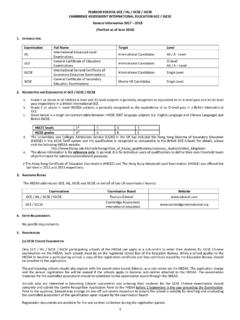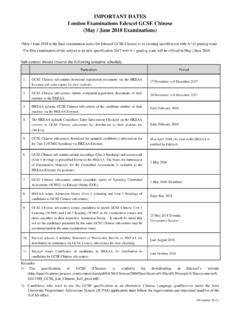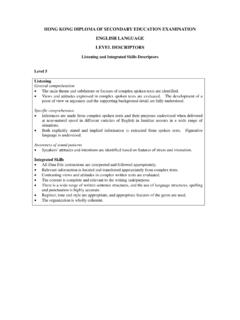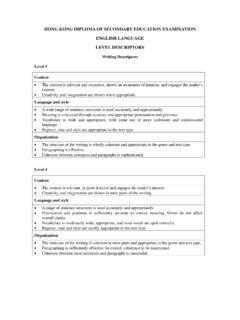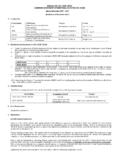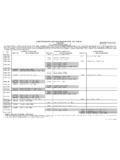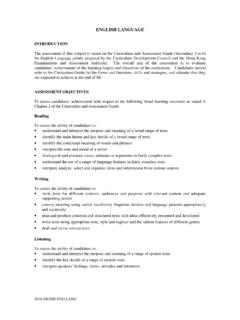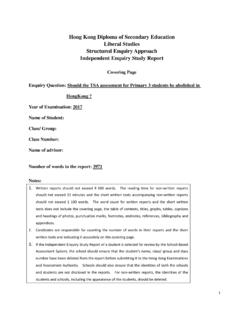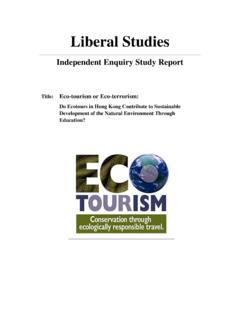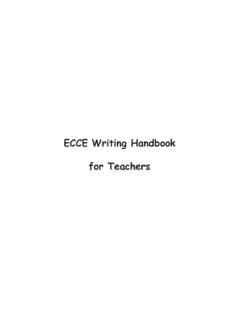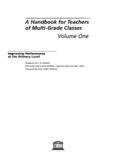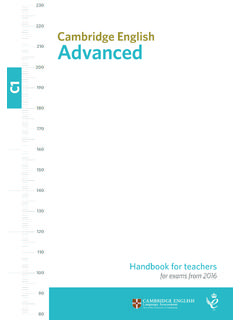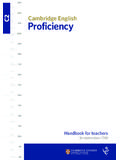Transcription of English Language School-based Assessment …
1 Hong Kong Diploma of Secondary Education Examination 2013 English Language School-based Assessment Teachers handbook TABLE OF CONTENTS Page Preface 1 Notes on Changes to the handbook 1 Chapter 1 Introduction 2 Assessment Framework Aims and Objective Chapter 2 Assessment Requirements 5 SBA Requirements Mandatory Assessment Conditions Setting Assessment Tasks Guidance in Assessment Process Assessment Criteria Chapter 3 Guidance in the Conduct of the SBA 14 Provision of Information to Students Guidance from Teachers Authentication of Students Work Within- school Standardisation Inter- school Sharing Sessions Handling Queries against Assessment Decisions Record Keeping Chapter 4 Administrative Arrangements 18 Participating in the SBA Absence from Assessment Students with Special Educational Needs Submission of SBA Marks Declaration Requirements Chapter 5 Moderation of SBA Marks 20 Rationale for Moderation of SBA Marks Moderation Mechanism Chapter 6 Malpractice 21 How to Handle Malpractice Prevention of Malpractice Appendices A.
2 Roles and Responsibilities of the HKEAA, EDB, Schools and 23 Students B. Roles and Responsibilities of Supervisor, District Coordinators 25 and school Coordinators C. Calendar of Events 27 D. Channels of Communication 29 E. Assessment Record Forms 30 F. Framework of Guiding Questions 34 G. Summary of Teaching and Learning Process 35 H. Recommended SBA Practice 36 I. Teachers Guidelines for Student-oriented Criteria 39 Preface This handbook serves as a guide to schools and subject teachers for administering School-based Assessment (SBA) for English Language at their schools for the Hong Kong Diploma of Secondary Education (HKDSE) Examination.
3 Teachers are expected to comply with the requirements and procedures stipulated in this handbook when conducting the related Assessment activities. Notes on Changes to the handbook The SBA requirements as stipulated in this handbook are similar to those in the 2012 Teachers handbook . Only the following paragraphs have been revised and the changes are highlighted in this handbook for teachers easy reference: Paragraph Requirements for Repeaters and Transfer Students Paragraph Assessment Criteria Appendix C Calendar of Events Appendix H Recommended SBA Practice The SBA requirements and procedures in the HKDSE will be subject to review in light of experience from the 2012 examination. Schools will be informed of any changes with an adequate period of notice.
4 1 Chapter 1 Introduction Assessment Framework The public Assessment of this subject is based on the English Language Curriculum and Assessment Guide (Secondary 4 6) jointly prepared by the Curriculum Development Council and the Hong Kong Examinations and Assessment Authority (HKEAA). It will consist of a public examination component and an SBA component as outlined in the following table: Component Weighting Duration Public Examination Paper 1 Reading Paper 2 Writing Paper 3 Listening & Integrated Skills Paper 4 Speaking 20% 25% 30% 10% 1 hours 2 hours About 2 hours About 20 minutes School-based Assessment (for school candidates only) 15% Aims and Objectives The rationale for introducing the SBA component to the HKDSE English Language Examination is summarised below: It provides a more balanced and trustworthy Assessment system, increasing the range and diversity of Assessment collection points, task types and assessors.
5 It improves the validity of oral Language Assessment in particular by including aspects that cannot be assessed in public exam settings. It improves the reliability of oral Language Assessment because judgements will be based on many observations of the student over an extended period of time. There is beneficial washback on teaching and learning, particularly in relation to the development of speaking and extensive reading skills, but also on teaching and Assessment practices more generally. It empowers teachers to become part of the Assessment process and enhances collaboration and sharing of expertise within and across schools. It has a professional development function, building up practical skills in teacher Assessment which can then be transferred to other areas of the curriculum.
6 2 The distinctive characteristics of SBA (and its strengths as one relatively small component of a coherent Assessment system) have implications for its design and implementation, in particular the nature of the Assessment tasks and role of the teacher standardisation procedures.
7 These implications are summarised as follows: the Assessment process should be linked to and be a logical outcome of the normal teaching programme, as teaching, learning and Assessment should be complementary parts of the whole educational experience ( the SBA component is not a separate one-off activity that can be timetabled or prepared for as if it were a separate element of the curriculum); the Assessment process should provide a richer picture of what learners can do (with oral Language ) than the external examination (Paper 4) by taking more samples over a longer period of time and by more closely approximating real-life and low stress conditions ( the SBA component is not a one-off activity done under pseudo-exam conditions with unfamiliar assessors).
8 The focus of the Assessment tasks should be on the speaking ability of the students, including their ability to discuss issues in depth and to convey their ideas clearly and concisely ( the SBA component is not an Assessment of the students memorisation skills, nor of their ability to provide highly specific factual details about what they have read or viewed, nor of their ability to conduct literary analysis of the texts); the nature and number of the Assessment tasks need to remain somewhat flexible so that there can be congruence between the learning and Assessment activities and more than one opportunity to collect Assessment samples ( the SBA component is not a single rigid highly standardised prescribed task which can be rehearsed and prepared for, then assessed, as if an external exam); the Framework of Guiding Questions (see Appendix F) should be used flexibly to ensure that students have the opportunity to show the full range of their responses, hence achieving the most valid true judgement of students ability ( the SBA component is not designed around a set of standardised questions with the same questions asked of all students.)
9 Fairness is achieved in a different way to traditional approaches to testing which assume all students must be treated the same); the formative/summative distinction exists in SBA but is much less rigid and fixed than in a testing culture, students should receive constructive feedback and have opportunities to ask questions about specific aspects of their progress after each planned SBA Assessment activity, which will both enhance Language development and help students prepare for the final oral external examination ( the SBA component is not a purely summative Assessment ); the marking criteria and standards will be explicit and publicly available to all, albeit in different forms for different audiences, students, parents, teachers and employers ( the SBA component does not rely on impressionistic marking or implicit judgements).
10 3 the marking criteria and standards should be regularly discussed with students and actively used by them, albeit in adapted form, as part of self and peer Assessment for formative purposes throughout S4 to S6, not just when they are being formally assessed, so students can monitor their own progress and standing over the three years ( the SBA component does not assume that the marking criteria are only useful for teachers and for summative Assessment ).
